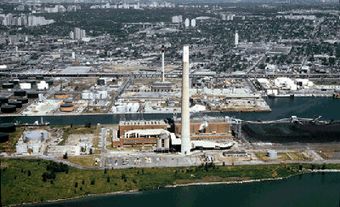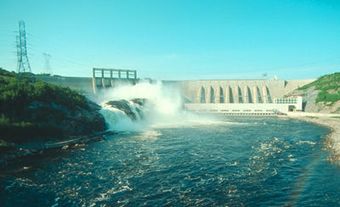In 1971, Hydro-Québec and the government of Quebec initiated the James Bay Project, a monumental hydroelectric-power development on the east coast of James Bay. ( See also Hydroelectricity in Canada.) Over the course of two phases, a total of eight generating stations were built, allowing for the pollution-free production of a significant portion of Quebec’s electricity. However, the project also profoundly disrupted the environment and the Indigenous communities living in the region, the effects of which are still being felt today.
Phase I
Phase I of the project cost $13.7 billion and entailed massive diversions of water from the Eastmain, Opinaca and Caniapiscau rivers to dammed reservoirs on La Grande Rivière, increasing the average flow of La Grande Rivière from 1,700 to 3,300 m3/s. A tiered spillway, three times the height of Niagara Falls, was blasted from the bedrock. La Grande-2 (LG-2) power station, now known as the Robert-Bourassa, was completed in 1982 and remains North America’s largest power-generating site, measuring 483 m in length and with the capacity to produce 7,722 megawatts of electric power. The completion of LG-3 and LG-4, in February 1984 and May 1984, respectively, ended Phase I of the project.
Social and Environmental Impacts
The James Bay Project, which started without the permission of the area’s Cree and Inuit peoples, raised controversy for its effects on Indigenous communities in the area and on the environment. When the project was announced by Quebec Premier Robert Bourassa, it was contested by the Cree, who had not been notified. The dispute culminated in 1975 with the James Bay and Northern Quebec Agreement. ( See also Treaties with Indigenous Peoples in Canada.) In the agreement, the Cree and Inuit surrendered their land claims for $225 million, retaining special hunting and fishing rights (see Fisheries).
The project flooded 11,500 km2 of wilderness land that was home to the James Bay Cree and Inuit. The village of Fort George (population 2,373), at the mouth of La Grande Rivière, was uprooted and relocated upstream. It is now called Chisasibi. The village of Eastmain now lies in a saltwater estuary, as Rivière Eastmain was reduced to a trickle. The flooding also created mercury contamination in fish, as mercury was released from rotting vegetation in the reservoirs, and contributed to the deaths of an estimated 10,000 caribou. Vast areas of wilderness were inundated (flooded) and forests were incinerated (burned) in an attempt to clear debris.
Phase II
Phase II of the project began in 1989 with the development of LG-1 at the mouth of La Grande Rivière, where it empties into James Bay. During this second phase of the James Bay project, the Projet Grande-Baleine (Great Whale Project) and other dams on the Great Whale, Nottaway and Rupert rivers were proposed. Opposition to this phase of the project by the Cree was more vehement than it had been to Phase I. Their resistance played out in court battles with the government, as well as lobbying efforts south of the Canadian border, given that power from James Bay II was slated to be sold to the states of New York, New Hampshire, Maine and Vermont. For years, Cree activists lobbied American legislatures to stop participating in the James Bay projects. Eventually, they were successful: in 1992, Mario Cuomo, then-governor of New York, directed the New York Power Authority to cancel its contract with Hydro-Québec in favour of energy conservation and to purchase power from other sources. Due to the lack of a market for its hydropower, completion of the Great Whale Project was suspended indefinitely.
Together, James Bay I and II diverted and dammed more than half a dozen free-flowing rivers and flooded an area one-third the size of Belgium.
Rupert River Diversion
In 2002, the Cree and the government of Quebec signed another agreement, called the Agreement Concerning a New Relationship Between the Government of Québec and the Crees of Québec (also known as the “Paix des braves”). (See also Treaties with Indigenous Peoples in Canada.) The agreement builds on the James Bay and Northern Quebec Agreement and stipulates that the Cree and the government should jointly manage Cree lands, as well as share revenues generated from mining, forestry and hydroelectric resources. Following the Paix des Braves, an agreement reached in 2004 set into motion the environmental assessment for the diversion of one of Quebec’s largest rivers, the Rupert River. In November 2006 and February 2007, the estimated $4 billion project received the required approvals. The construction of generating stations (Eastmain-1-A and Sarcelle) and the diversion of the Rupert River were completed in 2012. The diversion of the Rupert River toward La Grande power station has reduced the average water flow at the mouth of the river by 50 per cent annually, which has decreased the amount of freshwater flow into Rupert Bay by 18 per cent.

 Share on Facebook
Share on Facebook Share on X
Share on X Share by Email
Share by Email Share on Google Classroom
Share on Google Classroom











